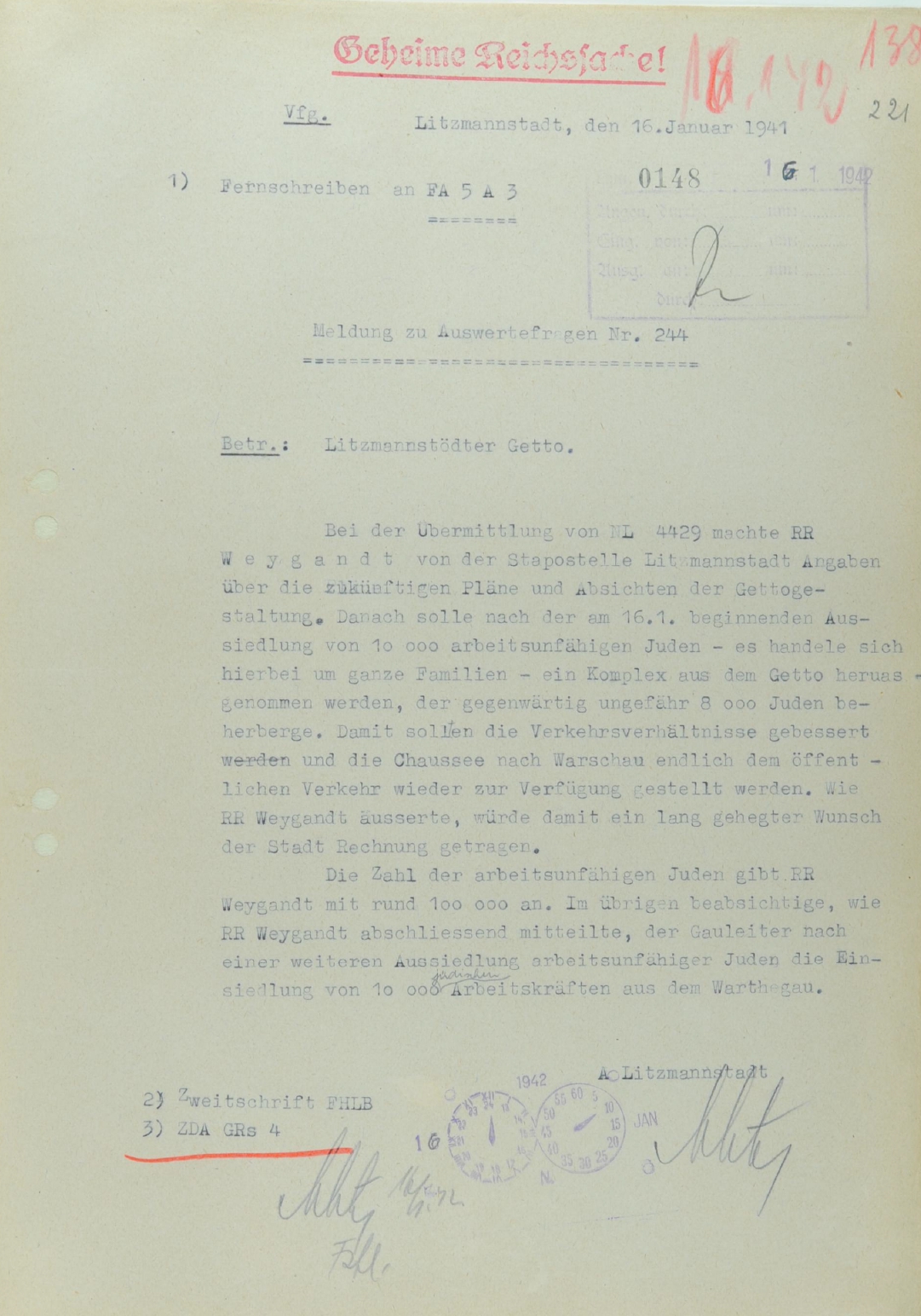Introduction
The document, dated January 16, 1941, was addressed from Forschungsstelle A in Litzmannstadt to Forschungsamt 5 A 3. Both offices were part of Hermann Göring’s Secret Service, the Forschungsamt of the Reich Ministry of Aviation. The telex communicates details from Herbert Weygandt of the Stapo office in Litzmannstadt about forthcoming actions in the ghetto. He mentioned the planned “resettlement beginning on January 16 of 10,000 non-working Jews – involving whole families” and following this “a complex currently housing approximately 8,000 Jews will be removed from the ghetto”. Weygandt also estimated “the number of non-working Jews at around 100,000” and indicated “further resettlement of non-working Jews, to bring in 10,000 Jewish workers from the Warthegau”. The removal of a section of the ghetto “intended to improve traffic conditions and finally make the highway to Warsaw available for public use again”.
This document reveals a strategy of step by step progress taken by the Nazi officals to exterminate the Jews, which was orchestrated under the guise of economic, hygienic, infrastructural etc. improvements. This approach also helped to maintain a façade of legality and administrative normality amidst the atrocities.
Document

Geheime Reichssache!
Vfg.
Litzmannstadt, den 16. Januar 1942
1.) Fernschreiben an FA 5 A 3
Meldung zu Auswertefragen Nr. 244
Betr.: Litzmannstädter Getto.
Bei der Übermittlung von NL 4429 machte RR Weygandt von der Stapostelle Litzmannstadt Angaben über zukünftige Pläne und Absichten der Gettogestaltung. Danach solle nach der am 16.1. beginnenden Aussiedlung von 10 000 arbeitsunfähigen Juden – es handele sich hierbei um ganze Familien – ein Komplex aus dem Getto heruasgenommen [sic!] werden, der gegenwärtig ungefähr 8 000 Juden beherberge. Damit sollen die Verkehrsverhältnisse gebessert werden und die Chaussee nach Warschau endlich dem öffentlichen Verkehr wieder zur Verfügung gestellt werden. Wie RR Weygandt äusserte, würde damit ein lang gehegter Wunsch der Stadt Rechnung getragen.
Die Zahl der arbeitsunfähigen Juden gibt RR Weygandt mit rund 100 000 an. Im übrigen beabsichtige, wie RR Weygandt abschließend mitteilte, der Gauleiter nach einer weiteren Aussiedlung arbeitsunfähiger Juden die Einsiedlung von 10 000 jüdischen Arbeitskräften aus dem Warthegau.
A Litzmannstadt
[Unterschrift]
2.) Zweitschrift an FHLB
3.) ZDA GRs 4
Secret State Affair!
Instruction
Litzmannstadt, January 16, 1942
1.) Telex to FA 5 A 3
Report on Evaluation Issues No. 244
Re: Litzmannstadt Ghetto.
During the transmission of NL 4429, RR Weygandt from the Stapo office in Litzmannstadt provided information about future plans and intentions for the restructuring of the ghetto. According to him, following the resettlement beginning on January 16 of 10,000 non-working Jews – involving whole families – a complex currently housing approximately 8,000 Jews will be removed from the ghetto. This is intended to improve traffic conditions and finally make the highway to Warsaw available for public use again. As RR Weygandt expressed, this would fulfill a long-held desire of the city.
RR Weygandt estimates the number of non-working Jews at around 100,000. Furthermore, as RR Weygandt concluded, the Gauleiter intends, after further resettlement of non-working Jews, to bring in 10,000 Jewish workers from the Warthegau.
A Litzmannstadt
[Signature]
2.) Second copy to FHLB
3.) To the files GRs 4
Archivial reference:
YVA O.51/13, p. 221

